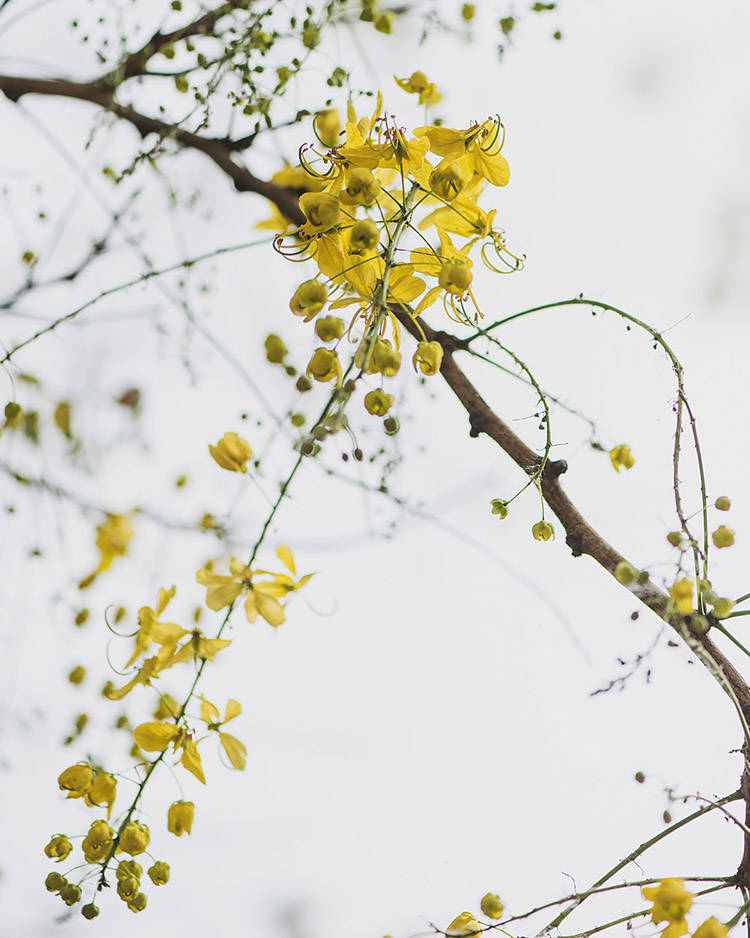



Summer is the season of the Sun; when it is at its fiercest, spreading heat, with dry, hot winds blowing, seeming to sap out the fluids from all living things. But this is also the season of small, cooling delights – the earthy aroma of Vetiver, the delight offered by soft white mulmul, the sweetness of Mangoes and joy offered by water in all its forms

The white-attired legion of Rudra comes round in Summer;
it hits the entire earth with its incomparable heat.
Grishma Rtu arrives in a blaze of light – searing, intense, scorching. The two lunar months of Jyeshta and Ashadha are quite possibly the two most difficult months in many parts of India. Grishma Rtu is the apotheosis of the Sun’s fiery heat and energy. Kalidasa’s Ritusamharam: A Canto of Six Seasons begins with Grishma Rtu and it describes summer thus: “The wind may be unbearable, so laden with dust it is; the earth may be lying scorched, in the fierce blaze from the sun… In that heat, the animals too, suffer greatly – their mouths are dry and parched with a terrible thirst; looking at the sky, so sombre, as if with sprinklings of dark powder, and imagining that a sign of water, they run towards another forest.” The qualities that are most associated with Summer are those of heat and dryness; the quality attributed to Grishma in the Vedic understanding is Sushma or Tejas, which is one of drying up liquid or enervating in nature and impact.
The annual Rtu Chakra – the cycle of seasons is a luni-solar one, meaning that each season is characterised by the Lunar cycle (the two lunar months that comprise a season or rtu) and the Solar cycle (the two ayanas or periods into which the year is divided based on the Sun’s Ecliptic or apparent path in the Earth’s sky). Uttarayana, meaning northward or upward period, is approximately from the winter solstice to summer solstice. Uttarayana is also known as the fiery Solar half of the year. On each day of the Uttarayana the Sun rises more and more towards the North and the heat of the Sun increases and reaches its zenith with the Summer Solstice. And Grishma is the season of the Sun, when it is at its fiercest, spreading heat, with dry, hot winds blowing, seeming to sap out the fluids from all living things. Once, before the spread of modern medicine, this was also the season of epidemics when minor goddesses such as Sitala (the goddess who presided over Samll Pox) needed to be appeased or cooled. So widespread were these disease cycles and the associated belief structures that sculptures dedicated to these goddesses have been found in sites such as Gandhara even in Buddhist monasteries. But this appeasement of the local goddesses also resonates with the characterisation of the hotter half of the year as the time of masculine energy. The latter half of the year – Dakshinayana is considered to be the time of the Moon and characterised by feminine energy.

The colour most strongly associated with summers is Shvet or white. Even the Vedic deities who governed summer were the “white-attired legion of Rudra”. Rudra is another name for Shiva.
But once the two months of Grishma were also called Sukra and Suci. These two names were perhaps the earlier, older names for months. The reference to these names occurs in the Taittiriya Samhita. According to Dr Raghavan, these were the names that were used for the months before the lunar months were named after constellations associated with the full moon, giving us Jyestha and Ashadha as the two summer months. The etymology and meaning that Dr Raghavan associates with these earlier names is evocative and perhaps more accurately conveys the essence of the season through the naming of the months. “In the classical lexicons, the etymologies offered for these (the names of the months) are those bearing the background for later love poetry,” writes Dr Rhaghvan. Sukra and Suci are both derived from the root of Suc and convey the sense of sorrow that assails the lovers who are separated in the summer season. Summer was the time of travel and work, when lovers would wait to meet again. But it seems that Sukra and Suci also refer to the brightness and light that characterises the summer season.
Grishma is the season of stillness and longing. After the playful dance of the elements – the gentle breeze, the rippling water, the rustling of the tender new leaves, the blooming radiance of flowers, the buzzing of the bees – that enthralled the senses in Basant Rtu, comes the stillness of summer. In the sere heat of summer there is a quality of watchful waiting – all living things conserve the energy that the heat of the Sun seems to leach away. The waters are still, the leaves no longer rustle. The birds and bees and all living things wait out the heat of the day by seeking shade.
But to each season there is its own beauty and small pleasures.
Summer has arrived, my dear.
The sun is fierce, the moon sought after;
to plunge in pools of shaded water
is to be immersed in pleasure;
lovely is the end of day
when desire calmed does stay.
This season of intense heat and stillness and longing is also the time when small pleasures are magnified – the coolness of a darkened room during long, hot afternoons; the scent of water passing through Khus (Vetiver) Chiks (traditionally woven blinds); the almost unbearable sweetness of a ripe Mango; the call of the Koel that seems to break through the still heat; a whiff of Sandalwood; tall cold glasses of Nimbu paani (lemonade); the seductive beauty of a full Moon when the night offers a short reprieve from the oppressive heat of the day; the appeal of cool white clothes in Muslin that is lighter than air, the deepness of Indigo that makes you think of water… summer is also the time of cooling delights.
In nature summer is the season when all the laws are turned upside down – prey and hunters alike will gather at the shrinking water holes in the forest to quench their thirst. Amorous desire among humans is lessened by the enervating heat. All things that offer cool relief are sought. Once, when we lived fully in harmony with the rhythms of the natural world, Grishma was the season for seeking cool relief in everything. Foods that lessened the impact of heat – Aam Panna (beverage made from raw mangoes), Nimbu paani (Lemonade), Yoghurt and Buttermilk, Cucumbers and Melons, raw Onions – dominated traditional diets in this season. Attired in the purest of cottons and the softest of mulmuls, in a palette of soothing colours – white and the softest of pastels, men and women adorned themselves with flowers of Mogra and smeared their bodies with the cooling paste of Sandalwood. And the scent that pervaded homes on hot afternoons was the rich, bittersweet fragrance of the damp earth itself – Khus or Vetiver.
The colour most strongly associated with summers is Shvet or white. Even the Vedic deities who governed summer were the “white-attired legion of Rudra”. Rudra is another name for Shiva. The fiery heat of anger, the power and thrall of an uncontrolled fire and the destructive potency inherent in extreme experiences are all attributed to the deity Shiva, who by association becomes the energy of this season of intensity. And white, the colour of Shantih is also the colour of the blazing, intensely brilliant light of the incandescent Sun of Grishma.